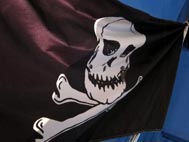一枚の特選フォト⌈海 & 船⌋
One Selected Photo "Oceans & Ships"
Back to: Top Page |
海賊旗のいろいろ [カナダ・バンクーバー海洋博物館]

|
カナダのバンクーバー海洋博物館内に海賊展示コーナーがある。世界海賊史にその名を残す海賊ヘンリー・モーガン、女海賊アン・ボニーや
メアリー・リード、キャプテン・キッド、「黒ひげ (Blackbeard)」の異名をもつエドワード・ティーチなどの他、回教徒の海賊、南シナ海など
で荒らし回った中国人・日本人海賊などについて俯瞰している。画像はそこに展示される海賊旗のいろいろである。
パネルには次のような説明文が綴られている。
When pirates flew a flag, it was usually the same one as flown on the ship they were about to capture. This was done to fool the other ship into thinking a friendly vessel was approaching. Once in cannon range, they would strike or lower that flag and raise the "Jolly Roger". While most people think of the black flag with a skull and crossbones, the original pirate flag was a red one. The red flag meant "no quarter", or a fight to the death. The red flag was known to the French as the "Jolie Rouge". English-speaking pirates transferred the name to the black flag in the early 18th century as "Jolly Roger". The skull and crossbones mean death and their use on pirate flags dates to the end of the 17th century, when the black flag was introduced. Over the next decades, pirates used the skull and crossbones, skeletons, crossed cutlasses, hourglasses, darts, hearts and other images on their flags. Famous pirates had their own flag and their ships could be identified by it. An unlucky mariner could see to his horror that Blackbeard or Calico Jack Rackham was closing in on him. The more fearsome the pirate's reputation, the more likely the sight of his flag was to inspire his prey to surrender. [参考] quarter: n.[軍]寛大、慈悲; [降伏者による]助命、命乞い. 海賊旗と言えば、ほとんどの人は黒色の布地に頭蓋骨および交差させた2本の骨を描いた旗 (black flag with a skull and crossbones) を思い浮かべるが、もともと海賊旗というのは赤色の旗であった。海賊にとって赤色の旗というのは、降伏した者や捕虜にした者に 「命乞いを許さず」("no quarter")、あるいは死ぬまで闘うということを意味した。その赤色の旗はフランス人には「ジョリ・ ルージュ (Jolie Rouge)」として知られていた。 英語圏の海賊らは、18世紀初期になって、その名前を「ジョリー・ロジャー (Jolly Roger)」として黒色の旗に取り換えてしまった。
[2015.2.2-17 カナダ&キューバの旅/記 2015.3.16/画像出典: バンクーバー海洋博物館/館内には小さいながら海賊 展示コーナーがある][拡大画像: x26622.jpg][拡大画像: x26624.jpg: 説明書き "Pirates Flags" ][拡大画像: x26623.jpg] |
Back to: Top Page |
 頭蓋骨および交差させた2本の骨は死を意味したが、海賊による頭蓋骨と交差骨 (skull and crossbones) をあしらった海賊旗の使用は、
その黒色の旗が導入された17世紀末期にさかのぼる。
その後数十年間に、海賊たちは、頭蓋骨と交差する骨、骨格 (skeletons)、交差させた短剣 (crossed cutlasses)、砂時計 (hourglasses)、
ダーツやハート、その他のイメージを自分たちの旗に用いた。名の知れた海賊たちは自身の独自の旗を用いた。それによって彼らの
海賊船を見分けさせることができるようになった。
航海途上で不幸にして自分たちに近づいて来る船に掲げられた旗を見分けた船乗りたちは、その悪名高い海賊「黒ひげ (Blackbeard)」、
あるいはキャリコ・ジャック・ラッカムによる完璧なまでの無慈悲な略奪行為は避けられないと悟り、その災難を嘆き、恐怖におのの
いたのである。
遭遇した海賊に対する風評がより恐怖心を掻き立てるものであればあるほど、そんな海賊には無駄な抗戦をせずにいち早く降伏してしまおう
という気にさせたことであろう。
頭蓋骨および交差させた2本の骨は死を意味したが、海賊による頭蓋骨と交差骨 (skull and crossbones) をあしらった海賊旗の使用は、
その黒色の旗が導入された17世紀末期にさかのぼる。
その後数十年間に、海賊たちは、頭蓋骨と交差する骨、骨格 (skeletons)、交差させた短剣 (crossed cutlasses)、砂時計 (hourglasses)、
ダーツやハート、その他のイメージを自分たちの旗に用いた。名の知れた海賊たちは自身の独自の旗を用いた。それによって彼らの
海賊船を見分けさせることができるようになった。
航海途上で不幸にして自分たちに近づいて来る船に掲げられた旗を見分けた船乗りたちは、その悪名高い海賊「黒ひげ (Blackbeard)」、
あるいはキャリコ・ジャック・ラッカムによる完璧なまでの無慈悲な略奪行為は避けられないと悟り、その災難を嘆き、恐怖におのの
いたのである。
遭遇した海賊に対する風評がより恐怖心を掻き立てるものであればあるほど、そんな海賊には無駄な抗戦をせずにいち早く降伏してしまおう
という気にさせたことであろう。